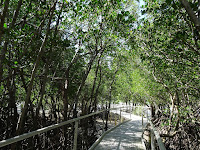Day 1 - Getting to Elsey NP, overnight at Jalmurak camp

[Kyle]On Day One of the big road trip, we presented ourselves at Traveller's Autobarn to pick up our rented camper van for the week. Once we had been given the tutorial, we headed off to drive as close as we could get to the far end of our planned route, and then we could spend the following days slowly making our way back to Darwin.
We had originally planned on visiting Kakadu National Park, but after talking to a few locals at a wedding we had accidentally crashed, who called it Kaka-don't, they all assured us we would have a much better time focusing on some of the Northern Territory's other parks. Maryanne was especially good at resisting her natural urge to stop and look at things along the way and we managed to make it all of the way to our turnaround spot at Mataranka.
It had been a long drive and I was happy to call it a day, but Maryanne had found out that the adjacent campground was having live entertainment tonight (damn internet!) and was pretty clear that she wanted to go as a consolation prize for missing all of the other stuff. Fine!
The headliner for the night was Nathan “Whippy” Griggs, current holder of three world records for whip cracking, two for speed, one for biggest whip cracked (100m). We left our basic Park Service campground early for the posh private one. They have a hot springs nearby as well as a bar and a little store, so we figured we would be able to keep ourselves entertained until Whippy showed up.




Day 1 - hit the road, a pub lunch and a campsite with entertainment
What we found on arrival was someone else, Whippy's opening act, a man whose name I know, but would rather not repeat for his sake. I take it Whippy is usually on tour, but since coronavirus hit, he has had to stay put and let the crowds come to him. His lead-in guy seems to be a legend in Mataranka's country music scene. To do this, you apparently have to have one of two things: a karaoke machine and a genuine Stetson cowboy hat. This guy had both, plus he looked like a good-ol-boy from Mississippi, so he was THE guy.
His act had me cringing the whole time. Not just because I have never figured out how to like country music, but because he was butchering even the tolerable songs. His voice wasn't so bad. His main problem was that his “Backup Band” was his karaoke machine. Rather than playing the original songs minus the voice track, his versions were all cheesy Muzak-style reproductions that sound like the canned music you get when you press the “Country” button on your new electric organ. Not only that, but they were squished-together medleys. His best song was a three minute medley of ALL Johnny Cash songs, one bar of each. He seemed to be enjoying himself, leaning on his stool, belting away with a six-pack of empties at his feet. Some of the drunks in the crowd even encouraged him by cheering or shouting out requests for songs that really shouldn't be sung around the children in the audience. He finished with his own special rendition of “Waltzing Matilda”, which got the Aussie crowd up on their feet crowing along like Irishmen in a pub singing “Danny Boy”. I have to admit I cheered myself at that one. I may have even shed a little tear because I was so happy he was done for the evening.
Next up was Whippy. Luckily, Whippy was as entertaining as the previous guy was not. He was witty and likeable and able to poke good fun at himself. We were surprised how young he looked. He seemed to be in his twenties. We were expecting a world-record holder to be older for some reason. He addressed that before anybody even asked. After one particularly hard trick, he explained that it had taken him ten years to perfect it. “Imagine what I could have done if I had spent that time doing something like getting an education!”
His act was mostly two-handed whip cracking in time with decent music. It looked like a good workout. He seemed overdressed for the hot weather as the only one wearing jeans, but we later realized they were probably protection from the errant leg strike as the whips were flailing around him. He did admit to hitting a shoe at one point and seemed a little embarrassed by the error. In the end, I was glad Maryanne dragged me along. I really liked him. I just wish there were some other way to get a front-row seat than to endure an hour of the previous guy.
Day 2 - Exploring Elsey, and Nitmiluk NPs, overnight at Pine Creek
In the morning as we were packing up, Maryanne spotted a few biggish birds flitting around in a tree a few dozen meters away from our camp. Further investigation revealed it to be a small flock of Bower Birds. Our little group turned out to be a bunch of males being taught the finer points of perfect nest design by a more senior bird. If the nest is not just so, the female they are trying to impress may tear it down and make them start over. It's important to get it right.
Our first stop after leaving camp was the hot springs at the other campground. It was a bit crowded and man-made, but it was nice to get into some fresh water after the previous day's dusty trip. It turns out the hot springs are not hot because of any geothermal activity. Australia is one of the oldest land masses on earth and has no vulcanism. Instead, the 'hot' in the hot springs comes from the normal temperature at the pressure of the subterranean aquifer feeding it. The water is hot basically because Australia is hot. It comes out not at 60C or 70C, but ,more like 33C, so they are really more like slightly warm springs. That's fine, because the 40C days would make anything hotter unbearable.



A bowerbird entertained us from our campsite, we start to see a few termite mounds, and we soon find ourselves relaxing in the water to escape the heat - bliss




Swimming and enjoying the scenery at Mataranka Thermal Pool & Bitter Springs (both at Elsey National Park) and later at Leliyn (Edith Falls, Nitmiluk National Park)
After deciding our first hot springs was too crowded, we moved on to another. This one floated us down a stream edged with lilies. By the time we had walked back to our air-conditioned camper van, any refreshment we were feeling from our little dip was fast fading.
We had intended to go next to Katherine Gorge for the afternoon, but the tourist center in town told us that almost everything there was closed either due to Covid or bush fires. We decided to carry on to Edith Falls, a little further north.
We got there at the hottest part of the afternoon. Edith falls has a loop track that goes past upper and lower pools. Most visitors seem to only bother with the lower, which is only a five-minute walk from the car park. We decided to take the long way to upper pools and then return via the lower.
The walk was brutal. The sun was at an angle that was perpendicular to the hillside we were climbing. That same hillside was also blocking the wind, so we trudged upward in the crossfire between the scorching sun behind us and the radiated heat coming off of the rocks ahead. After only a kilometer of what would have otherwise been a moderate climb at worst, we had drained a liter bottle down each of our gullets and were diving into my pack for the emergency backup drinks.
As we crested the ridge, the upper pools came into view. They were beautiful and inviting and it was all we could do to keep from tripping and breaking something as we staggered to their sweet relief. Twenty seconds later, we were just fine. We were floating around in an amazing spot in a beautiful part of the world. We explored for a while and then, fully refreshed, crawled out into the heat for the walk down.
By the time we got to the lower pool, we were again desperately in need of another dip. Campers from the adjacent campground were setting up there for the evening, We weaved through them and lowered ourselves into water that actually felt cold for the first ten seconds. After that, we didn't want to get out. After looking at the campground earlier, though, we decided we would camp somewhere else, so we had to get going. We managed to take a pretty good chunk out of the next day's mileage before dark, where we found a much nicer campground with gleaming facilities.
I mentioned before that our camper van was air-conditioned. That is technically true. The area around the front seats is air-conditioned while we are driving. The living area in the back is not and only has a few screened windows for ventilation. Our campsite was nice, but the spaces were close together and separated by screens of foliage. That left us with no airflow at all, so there was no way it was going to be cool enough to sleep for hours after the sun went down. Fortunately, there was an adjacent pub (the Lazy Lizard) that served tasty food and really cold beers to help us pass the time until then.


We camped at the Lazy Lizard campgrounds, the adjacent pub was built with bricks cut from termite mounds
Day 3 - Douglas Daily (closed), Robin Falls (dry), Batchelor (fuel stop), and finally Litchfield NP, overnight at Florence Falls
{Maryanne:The Lazy Lizard campground was clean and nice, in that it had all new facilities (with entertaining use of beer barrels), but the best bit was a communal kitchen with a toaster so I was able to enjoy toast for breakfast. This simple household appliance which I miss terribly on the boat, provided a great start to the day}. After an uncomfortably warm, mostly sleepless night, we continued north via back roads to various creeks and waterfalls marked on our map. All turned out to be either bone dry or small pools of algae – all that remained after the long Dry Season. We eventually ended up in Litchfield National Park a day earlier than planned. There, we took in two different swimming venues before turning in for the night.





Once we made it to Litchfield National Park we found the really big cathedral termite mounds - and the amazing tombstone-like magnetic versions too (built by different species of termites)
We tend to hike a lot, looking for long trails to mountain top views, so it seems strange that most of the attractions in the NT are swimming holes. After spending a few days out here, we get it. The NT is pretty flat, so there aren't many long views to be had. Also, it is ridiculously hot, at least in "The Dry", so it is just not possible to survive outdoors without frequent cooling swims.
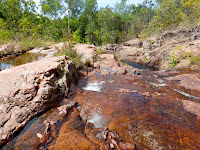

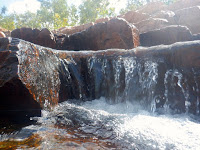




Relaxing in the waters at Buley Rockhole before moving on to Florence Falls (Litchfield NP)
We stayed the night at Florence Falls in a campsite chosen for its airflow. Florence falls is stunning. It is actually a big double fall into a giant, shaded plunge pool. At the beginning and end of the day, big flocks of birds descend to the upper pools for a drink. Most entertaining are the noisy cockatoos; they sometimes hang upside down and play with their friends while chattering away.
Day 4 - Exploring Litchfield National Park, overnight at Wangi Falls
On our next day, we made a few scenic stops and then camped at Wangi Falls. Wangi is bigger and maybe even prettier than Florence Falls. It is also way easier to access, so the camping area at the foot was already pretty full by the time we arrived. Like at Edith, we took the long loop foot-trail to the top and back before partaking in a life-restoring swim. Since we were camped nearby, I insisted we stay in the water until sunset. We were hoping to see the nearby roosting fruit bats go out for their nightly fruit hunt, but they waited until it was really dark before going and we were hungry, so we went back to the van for dinner.

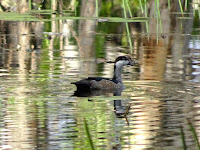



The calm waters of Tabletop swamp






Sights around the Tolmer Falls walk



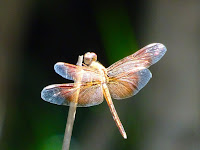

Greenant Creek / Tjaetaba Falls Walk







A nice walk ends with relaxing at the Cascades



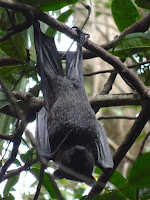


A long walk around Wangi falls before we finally took a swim, and among the local wildlife a wallaby comes begging to our camp
While at our camp, a little wallaby hopped into our site and just hung out with us for a while. We felt a little guilty with our nice peanut butter sandwiches while he was crunching away on dried leaves. We weren't sure if peanut butter was good for wallabies and he seemed to be content with his leaves, so we left it at that.
Day 5 - Leaving Litchfield NP for a tour at Corroboree Billabong, overnight at the Billabong
The wallaby joined us again for morning coffee before heading deeper into the bush for the day. We continued north and then east to the Corroborree Billabong. After we got going, we noticed that our A/C was not working. Each day, it had taken a little longer to get going - two minutes, then ten minutes, then an hour. Now it wasn't working at all. We were okay until 11:00am, when the blast of air coming through the windows became even hotter than the inside. We were in for a long day.



The old Tin mines at Bamboo Creek were our last stop at Litchfield NP
Before Corroborree, we stopped at Window on the Wetlands, mostly because it was on the way, indoors and probably air-conditioned. It was. The exhibits were pretty typical museum stuff, but the best part was an hour-long film showing the region through the year's seasons. The NT in the Dry Season is like Arizona. Everything is shriveled and brown and clinging to every remaining drop of withering moisture. It is hard to think of it as anything other than an approximation of the surface of Mercury.
We knew this isn't always the case. Every road has flood markers showing how deep the water gets at every low spot. Many locals say they are effectively cut off during the Wet every year and can only get supplies in by barge or air.
The film starts with the late Dry increase in humidity and the arrival of the first monsoon rains. Cracked earth turns to mud and the billabongs start to fill. Everything blooms. Then the rain starts in earnest. It rains hard and blows hard for months on end. The billabongs flow into the rivers, the rivers top their banks and the countryside floods. Almost the northern third of the NT becomes an inland sea under two meters of water, with just the tree tops and a few high places spared. Then Cyclone season begins. The pleasant trickle of the various falls we have been enjoying become dangerous Niagara-like torrents. Saltwater crocs use this time to travel freely to remote places, which is why it is not safe to walk near the edge of a billabong 100 miles from the sea during the Dry season. The film was a fascinating look into the other face of the NT and a powerful reminder that we needed to get Begonia out of here well before the Wet begins.

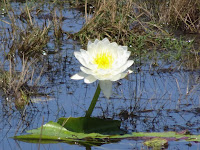
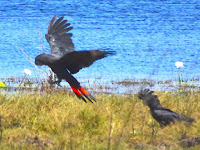


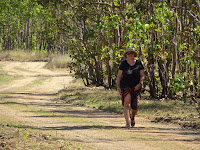
A side-stop to explore Leaning Tree Lagoon Nature Reserve Billabong


The kind of things you can see at a petrol station in Australia (Wallaby and Buffalo)
After our time in climate-controlled air, we headed back to our motorized greenhouse for the trip to Corroborree billabong. There, we paid for a sunset cruise (a wetlands wildlife tour) through the Corroborree and St. Mary's River. We saw lots of interesting birds and at least four crocodiles. The ones in the water did a pretty good display of how they are experts at disappearing without so much as a ripple. We also got to have some bush tucker – in this case, seed pods from the lilies lining the banks. They taste like snap peas. That goes into the category of good information that we will never use. To get to a seed pod, you have to wade into croc-infested waters.










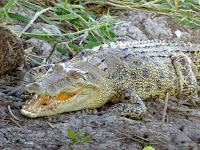
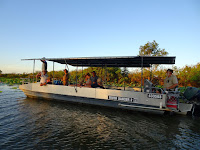

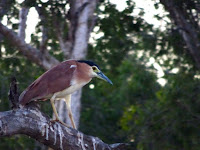

Sunset billabong cruise
Highlights for me were the Comb-crested jacana (aka Jesus bird), and the delicious bush-tukker
For the night, we camped at a spot recommended by the woman at the cruise company's booking office. It was way back from the river, but she explained, “There's fewer mossies there.”
Indeed there were. We walked back from the boat in bug-free comfort. Then, just as dinner was served, about an hour after sunset, every manner of biting insect descended upon us. There were thousands of them. (These very bugs were the main reason we were advised against going to Kakadu. I have been before and indeed, one of my main memories was being tormented by mosquitoes). We hastily shut ourselves inside and then after spending an hour killing all that made it in with us, we sat down to a lovely dinner that had since congealed into mush. Oh, I have so many reasons to hate mosquitoes!


Meanwhile this Whistling Kite hung around our campsite
Our sleep was fitful. Although we were pretty sure the sweltering interior of our van was bug-free, we could never be 100% sure and it was way too hot to cower under a sheet for protection. Then the bats arrived. We had parked under a tree that was loaded with nectar-bearing flowers. They weren't loud. Their little squabbles were actually kind of soothing. I fell asleep imagining that at least some of them were the other type of bat – the ones that can eat 1,000 mosquitoes a night.
Day 6 - Djukbing NP, Humpty Doo Hotel and back to Darwin
The bats were gone in the morning. That buzzing in my ears turned out to be bees cleaning up what the bats had missed. We treated 'em like bees; we didn't bother them, they didn't bother us. We decided to get moving before it got too hot.
We were heading back to Begonia via 'a few stores'. Our big grocery delivery had not included perishables. Stores are mostly air-conditioned, so we decided to pop into Djukbinj National Park (pronounced: Jook-binj) to see what was there. We found a few mostly dried-up billabongs and lots of birds to entertain, including an especially large flock of Corella Cockatoos.


Our last campsite


A side trip to Djukbinj National Park
In the spirit of stalling as much as possible before getting back to all of the work awaiting us at home, we popped in for lunch at the Humpty Doo Hotel. We were driving right by and it is prominently displayed on every map of the area in such a way that implies that it just should not be missed. The 'Historic' Humpty Doo Hotel has been in the same location since 1970. That is admittedly a long time for these parts. Several songs have been written about the place and it was one of the few buildings that survived Hurricane Tracy in 1974. Since then, it has become sort of a local icon.
As the only place in the area, people naturally stopped in. Then word spread and others came to see what all of the buzz is about. Maybe you bring a bunch of your mates and you all get a little too drunk and have a great time belting out “Waltzing Matilda”. All of you tell your other mates and pretty soon, the whole town is heading twenty miles into the bush to the Humpty Doo on a Saturday night. Some of them buy t-shirts and hats at the gift shop with the funny, memorable name on. They wear them out and now even perfect strangers want to know what the Humpty Doo is and how can they get there. Some people don't have an amazing night, but they don't want to feel left out, so they say they did. That plants the expectation of amazingness into the next groups heads, so they arrive looking hard for the amazing, so that they, too, will leave amazed.
It was amazing! Not for any of the usual reasons, but rather because it was completely lacking in any charm whatsoever. It wasn't even charming for being so charmless. It was just sitting there like a bowl of lukewarm oatmeal on an empty table. Literally every other single place we have ever been in Australia has been more interesting. They do serve some unusual fare, like buffalo, kangaroo and croc burgers, but they serve them in such a way as to be indistinguishable from regular beef burgers. Maryanne had a croc burger. It was not bad. That would be memorable. The portions were neither stingy nor generous, had little flavor and were served about ten degrees above the admittedly very high room temperature. They had nothing interesting on tap, just the same four beers served in every other pub in Australia. All are essentially flavorless lagers whose only redeeming characteristic is being below room temperature, and then only for the top half of the glass. The floor was bare concrete, the roof was tin. There wasn't much in the way of decor other than a few posters obviously provided by the breweries. It was as if the place had been carefully engineered to erase any memory of your visit by the time you pull back onto the highway.
We actually did have one amusing moment. When Maryanne ordered her croc burger, the woman behind the bar who took our order asked the one next to her, who seemed to be a trainee, if she had ever had one. She replied that she had initially avoided it because she's not supposed to eat seafood, but then realized that they were technically mammals, so then it would probably be okay. Did I mention the hot waitresses with the biting wit? No. I did not.


We had lunch at the famous (but mediocre) "Humpty Doo" hotel tavern
Meanwhile all the groceries stock classic Australian meats
We had originally planned on camping for the night somewhere north of Darwin, since we had the van for another day. By the time we got everything loaded onto Begonia, we had decided to spend the night aboard after all (and since we'd already paid the live-aboard fee, that felt fine). I was especially sick of that van. The marina had nice, cold (okay, lukewarm) showers and the fan in our berth was better. The hand fan we used in the van failed every time I fell asleep, which woke me up. Begonia has electric fans. Sure, it's still way too hot, but at least we can turn on the fan and leave it blowing all night.
Day 7 - Returning the campervan
Our next day was also mostly chores. We epmtied out the camper van and cleaned it to where we were sure we would get our deposit back (we did). We moved our bikes to the Darwin Sailing Club at Fannie Bay and then rewarded ourselves with a nice lunch at our soon-to-be home.


Our last day with the campervan was all chores
Leaving the Marina
The next high tide was in the morning, so we were able to leave our berth with no wind, gliding over a mirror of water. Maneuvering into the narrow lock was easier, although still tense. We were dropped three inches to the high tide level and then the sea gates were opened to let us free. Whoo, hoo! It is going to be so nice to be at anchor again.


Leaving the marina to return to anchor at Fannie Bay








